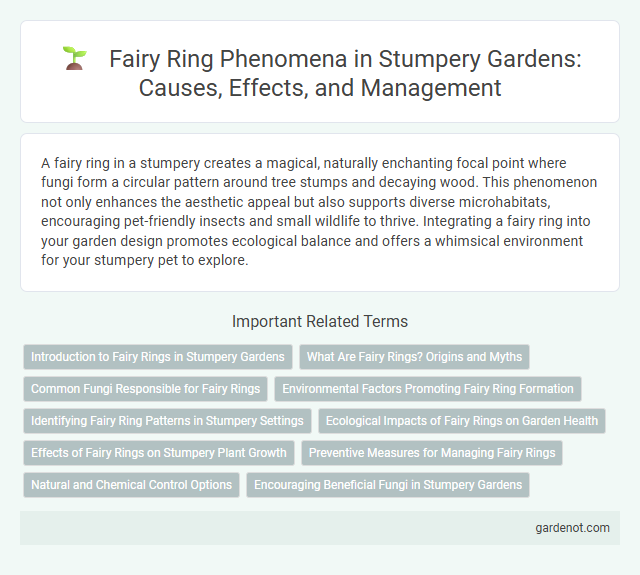A fairy ring in a stumpery creates a magical, naturally enchanting focal point where fungi form a circular pattern around tree stumps and decaying wood. This phenomenon not only enhances the aesthetic appeal but also supports diverse microhabitats, encouraging pet-friendly insects and small wildlife to thrive. Integrating a fairy ring into your garden design promotes ecological balance and offers a whimsical environment for your stumpery pet to explore.
Introduction to Fairy Rings in Stumpery Gardens
Fairy rings are naturally occurring circular formations of mushrooms or lush grass, commonly found in stumpery gardens where decayed wood and shade create ideal conditions. These mystical rings often indicate mycelial networks beneath the soil, playing a crucial ecological role in nutrient cycling and soil health. Incorporating fairy rings into stumperies enhances the garden's enchanting atmosphere while supporting biodiversity and fungal ecosystems.
What Are Fairy Rings? Origins and Myths
Fairy rings are naturally occurring circular patterns of mushrooms or lush grass that have intrigued cultures for centuries, often linked to folklore and supernatural beliefs. Their origins trace back to fungal mycelium spreading underground, creating these enigmatic circles, which many myths associate with fairies dancing or magical gatherings. Scientific studies explain the biological processes behind fairy rings, while cultural stories enrich their mystique across different regions.
Common Fungi Responsible for Fairy Rings
Common fungi responsible for fairy rings include Marasmius oreades, also known as the fairy ring mushroom, which thrives in grassy areas and forms distinctive circular patterns. Other notable species are Lepista personata and Agaricus campestris, both contributing to the characteristic ring formation through their mycelial growth beneath the soil. These fungi decompose organic matter, releasing nutrients that promote lush grass rings, creating the iconic fairy ring effect in stumperies and lawns.
Environmental Factors Promoting Fairy Ring Formation
Fairy ring formation is heavily influenced by soil composition, moisture levels, and organic matter availability, creating ideal conditions for fungal growth. High nitrogen content and well-drained sandy loam soils facilitate the rapid expansion of mycelium, promoting the characteristic circular patterns. Temperature fluctuations and seasonal rainfall also play critical roles in stimulating fungal activity and fairy ring development in natural and managed landscapes.
Identifying Fairy Ring Patterns in Stumpery Settings
Fairy ring patterns in stumpery settings can be identified by circular or arc-shaped arrangements of fungi growing around decaying wood. The growth usually forms a dark green ring of mushrooms or moss that contrasts with the surrounding soil or plant life. Recognizing these patterns involves observing the radial spread from a central point, often indicating underground mycelium networks.
Ecological Impacts of Fairy Rings on Garden Health
Fairy rings, formed by the mycelium of certain fungi, significantly influence garden ecosystems by altering soil nutrient distribution and moisture levels. These fungal networks can enhance soil fertility through organic matter decomposition while simultaneously creating patches of dense fungal activity that may inhibit plant root growth. Monitoring and managing fairy rings are essential for maintaining balanced garden health and preventing localized plant stress or decline.
Effects of Fairy Rings on Stumpery Plant Growth
Fairy rings influence stumpery plant growth by altering soil nutrient levels, often increasing nitrogen availability which can enhance certain plant species' vitality. The fungal mycelium associated with fairy rings can either promote or inhibit root development depending on the plant species and the specific fungi involved. These changes in soil conditions and microbial activity create unique microhabitats within a stumpery, affecting both plant diversity and growth patterns.
Preventive Measures for Managing Fairy Rings
Effective preventive measures for managing fairy rings in stumpery include maintaining even soil moisture through regular irrigation and aeration to reduce fungal growth. Applying balanced nitrogen fertilizers can inhibit the formation of dense mycelial mats associated with fairy rings. Early detection combined with proper organic matter decomposition helps minimize damage and supports healthy plant roots.
Natural and Chemical Control Options
Fairy rings caused by basidiomycete fungi can be managed using natural control methods such as aeration and topdressing with fresh compost to restore soil balance. Chemical control options include applying fungicides containing active ingredients like chlorothalonil or azoxystrobin to inhibit fungal growth effectively. Integrated management combining cultural practices and targeted fungicide applications enhances control of fairy ring severity on turfgrass.
Encouraging Beneficial Fungi in Stumpery Gardens
Fairy rings often indicate the presence of beneficial fungi that enhance soil health and nutrient cycling in stumpery gardens. Encouraging these fungi can improve plant growth by breaking down organic matter and releasing essential nutrients. Integrating decomposing wood and maintaining moist, shaded conditions in the stumpery supports the proliferation of these symbiotic fungal networks.
Fairy ring Infographic

 gardenot.com
gardenot.com